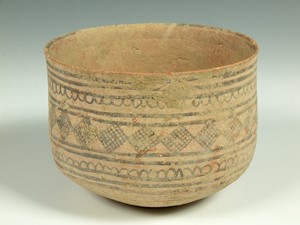Thinking about evidence
By Sarah Dodds
IT Trainer
On 5th December the Oriental Museum hosted a session “Thinking about evidence” for the postgraduate research students. Students were given objects from the museum’s handling collection and asked what they could deduce from them, whether they were real or fake and whether the objects could tell the students anything about their history from handling and observation.
Although on the surface, the session did not appear to be related to the research the students themselves are doing, there were in fact strong links between the two activities. Research itself may build upon existing knowledge, create new knowledge and concepts, and yet may be challenged and changed over time, just like the history of the objects in the collection.

Take two ceramic bowls gifted to the museum, bought innocently by the owner, one of which is possibly the spoils of war and may date back almost 5000 years, the other a modern copy. To the untrained eye these are difficult to identify, however a little knowledge about each sheds new light on our understanding of these objects.
It reminds us that all of our research has to be substantiated and proved and yet one day our current understanding may be challenged and new research may overturn our results. That does not discredit the work we researchers have done, it is simply the nature of research and something we should all be open to.
